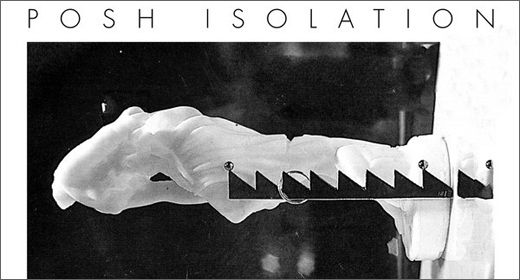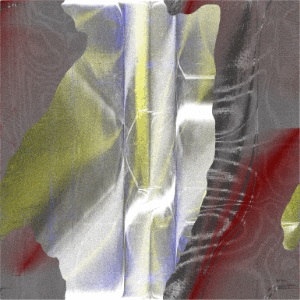The 9T Antiope duo band consists of Iranian musicians Nima Aghiani and Sara Bigdeli Shamloo. Working since 2014, their debut album Syzygys was released in December 2015. They have released three albums, one EP and five singles ever since and their latest album Nocebo is available on PTP this month (February 2019).

The sound of despair
The sound of despair might be best explained through rawly animal terms—of grunting and howling that grinds the ear to pulp. To create music in a historical moment such as this (a uniquely despairing one) is to reckon exactly with that animal shout, but also to find a space in which to drag some kind of poetry from it. Nocebo, the latest release from Iranian-born, Paris-based duo 9T Antiope—out from New York label PTP (Purple Tape Pedigree)—excavates exactly these emotions. It might only be the second month of the year, but we’ve already found something necessary, haunting, and beautiful.
Properly speaking, Nocebo is the second release in an ongoing series from Nima Aghiani and Sara Bigdeli Shamloo. Isthmus, the first installment, offered up plates of brute force and jagged shadow—it was principally about place or, as the collaborators put it, about creating “new worlds, using the sound identity of similar spaces in different locations around France and Iran.” Ultimately, they explained in an exchange of questions and documents, can we examine “the possibility of substituting the existing” worlds with those that are new? A lot of music assumes that everything is either unrepentantly shit or ok. It takes a great deal of courage to muscle into a utopian mindset. I haven’t seen much of that, of late.
Continuing that theme, Nocebo—split into two long parts, A and B—delivers the gut punch of this collaboration, in an excoriating study of isolation, melancholia, and of becoming comatose. It “recounts the stories of beings, who have given up on their space and time, thus forcing themselves into complete isolation and eventually a self-induced comatose state.” Never has the concept and experience of withdrawal sounded so present, so immediate. As Aghiani and Shamloo explained during our exchange: “In Nocebo, we’re exploring the idea of ‘non-location,’ of vacancy and of the spaces one could find inside.” There it is, again; the searching-outward, through music, toward the creation of real possible worlds. In other words, both Nocebo, and Isthmus before it, are exercises in world-building; in the creation, from the raw sump of lived experience and perception, of alternative positions. If that first release was all about location, then this, second, release is about dislocation. A third, Placebo, will follow. These are exciting conversations; and it’s yet more exciting to be in the midst of this creative journey.
And so, what about these interior worlds? What about Nocebo itself?
Part A kicks off with industrial, clacking disharmony, but eventually gives way to a plateau of silence, and a voice. This speaking is unexpected, but an essential part of what Aghiani and Shamloo are doing. The territory we enter is perilous, and not at all regular. Like the best experimental music, it grasps beyond the machine: not only voice, but string and wind. What emerges is a kind of collage, slaked down in great gobs and mallets of sound. If it were a painting the canvas would become torn, sagging and bulky with paint. As music, we’re greeted by something almost physical. I listened to this, and began writing, on one of those almost impossible February afternoons—the sky a wash of dusty blue and pink; the air warm, the wind gentle. Coming at me through my headphones, instead, was the counterpoint to all of this grace, in the way that, at this latitude, you can hear running beneath you the city’s victorian metro. The floor quakes, and moves, and rumbles. Something intense and muscular is being thrown around down there.
Nocebo had its first airing at last year’s CTM Festival and SET Experimental Art Events, which has a physical presence in Tehran. As you’d expect, the final product—parts A and B—is a whirlwind of intense drone and withering string, something easy to imagine being rocked into catatonia by in the darkened space of a venue. But it also translates beautifully to the digital context. In fact, considering the album’s exploration of removal and isolation, it’s almost the perfect space in which to encounter it. During all of this, I kept coming back to cultural theorist Edward Said’s moving description of exile—maybe the ultimate form of aching isolation—where he explains that: “its essential sadness can never be surmounted.” Isolation hurts because it cleaves a space between what is desired (home? place? our loved ones?) and the desiring subject. It’s fucking pessimistic, but that’s its power.

As Shamloo explained, the writing of Nocebo is part of an ongoing process begun after losing two brothers in a short space of time. “I eventually found refuge in writing about my relationship with death,” she explains, “either in forms of poems, texts, lyrics, or plain monologues.” These are the vocal textures we encounter in Nocebo. She continues that, for her, it’s been about “finding the audacity to explore all the things I took away with me during the time I had one of my brothers in a coma after his accident and the other in a comatose state after his cancer medications.” Now, they both argue, is the moment to confront experiences such as these in the open. The inner state is becoming an outer state. The physicality of the music is its product.
Part B begins with an overwhelming sense of disembodiment. A voice—frayed by digital hooks, made unreal—describes the experience of laying, comatose, eyes closed, while explaining the physical, visual properties of a painting that is suspended above the speaker. We encounter the bright tendrils of light that represent the veins running across the eyelid; drunk up by the iris. “I can feel the forms of a painting on the ceiling. I can feel the deep greens and the gold.” Ratcheting, clicking, electronic thuds veer and echo in the mix, accompanied by a sudden wail of diffused and atonal string; the heavy-handed mechanical clanking of rope-like notes, sounding almost like a player dragging a hammer across the taut spiral lengths of a piano’s strings. What hounds this music is a sense of urgency, and of alarm. Not only from the sussurating buzz of static (it reminds me of an exposed electric cable thrashing, spitting sparks), but the repetitive sway of a siren-like alarm that moves above it. If this were a building, a piece of architecture, people would be leaving. They would be running.
With so much talk of isolation, I asked Aghiani and Shamloo how this all folds back into an understanding of withdrawal as a conscious, protective thing—of the positives of removing oneself, set against the disadvantages. They cite fellow musician Siavash Amini, who points out that within this scene, “we are the voices who choose to be absent from the news and the musical mainstream (and in some cases the city of our birth) in order to express the range of emotions and ideas which make up our lives, as honestly as we can.” This is ‘absence,’ which gives life to new forms of exploration and experimentation. Is this the same as being rawly comatose, out of our own minds and bodies? “It’s a difficult place to be,” the duo explain. But the journey they’re creating, and the intensity of its new emotional worlds, paint a picture that is unmissable.
Ultimately, they explain, Nocebo is also a pretty good metaphor of the experimental music scene itself—for their own lives as creators. “We all tend to find each other around the world. We’re ‘isolated’ alongside our friends scattered around the world. Take this experimental music scene for instance; it’s a vastly isolated one. We’re all in a huge yet isolated scene.” Of course, what’s so promising about Nocebo—and the groundbreaking work of 9T Antiope—is that they’re reaching across this isolation. They’re always only the press of a button away.
Nocebo is available on PTP.
Visit 9T Antiope on Bandcamp, Soundcloud, Facebook, or Twitter.

















![Pole :: Tempus Remixes (Mute) — [concise]](https://igloomag.com/wp/wp-content/uploads/2025/04/pole-tempus-remixes_feat-75x75.jpg)






![Hasbeen :: Bunker Symphonies II (Clean Error) — [concise]](https://igloomag.com/wp/wp-content/uploads/2025/04/hasbeen-bunker-symphonies-ii_feat-75x75.jpg)
